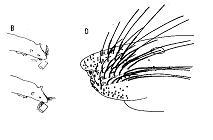Document Actions
H. P. Zeigler
Ph.D., University of Wisconsin, Psychology/Neurophysiology
|
Contact Information: |
 |
Current Areas of Research:
We use the rat's whisking behavior as a model system.for the study of active touch. We use computer-assisted optoelectronic techniques for monitoring whisking behavior, operant conditioning techniques to bring whisking movements under experimental control, and lesion and recording techniques to explore the function of brain regions.
1. Neural control of whisking: How does the brain use information delivered by its whiskers to control exploration, discrimination and orientation behaviors? In rats, rhythmic whisking (6-10 cps) functions like human hand movements to explore the environment. Whisking generates information about environmental features which are represented on the brain maps as patterns of neural activity. The rat's whiskers are arranged on its face in a very precise order on the face and this organization is represented as a whisker map at all levels of the brain. To understand how these brain regions mediate exploratory and discriminative behaviors, we use computer-assisted optoelectronics to monitoring whisking, operant conditioning techniques to bring whisking movements under experimental control, and lesion and recording techniques to explore the function of specific brain regions..
2. Development of the whisking system. We are interested in the contribution of experience to the development of this “active touch” system. For this reason we are studying how this complex, voluntary behavior develops from its first appearance in newborn animal and the role of whisking-generated sensations in the emergence and increasing sophistication of the system. We also ask how the development of whisker touch system interacts with the development of the visual system, and whether manipulations of one system can effect performance with the other.
 |
 |
(Left) Exploratory whisking. (Right) Low and high-resolution images of movements of individual whiskers on the right and left side of the face, obtained using a computer-assisted optoelectronic system.
Selected Publications:
Gao, P., Ploog, B.O. and Zeigler, H. P. Whisking as a “voluntary” response: operant control of whisking parameters and the effects of whisker denervation.Somatosensory and Motor Research, (2003) In press*. PDF File
Gao, P., Bermejo, R. and Zeigler, H. P. Vibrissa deafferentation and rodent whisking patterns: Behavioral evidence for a whisking Central Pattern Generator. Journal of Neuroscience, 2001, 21:5374-80*. PDF File
Harvey, M., Bermejo, R. and Zeigler, H. P. Optoelectronic monitoring of discriminative whisking in the head-fixed rat. Somatosensory and Motor Research, 2001, 18, 211-222. PDF File
Harvey, M., Sachdev, R. and Zeigler, H. P. Cortical barrel field ablations and whisking patterns in the head-fixed rat., Somatosensory and Motor Research , 2001, 18, 223-227*. PDF File
Sachdev, R. Jenkinson, E., Zeigler, H. and Ebner, F. 2001. Sensorimotor plasticity in the rodent vibrissa system. In: The Mutable Brain: Dynamic and plastic features of the developing and mature brain. Jon H. Kaas, ed., Harwood Academic Publishers, Amsterdam, pp. 123-164.
